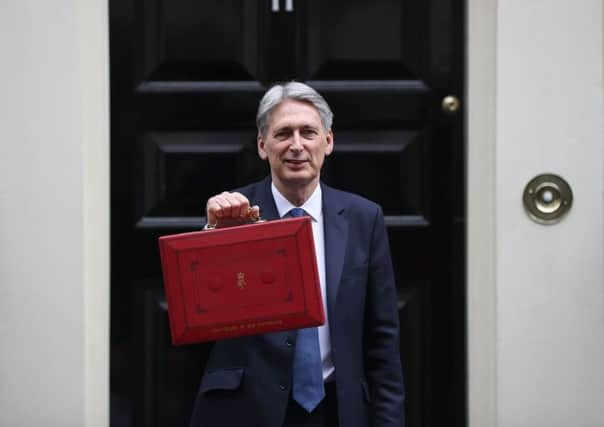Gareth Shaw: Tax relief on pensions could make Hammond's hit list


So, what can we expect this coming Monday? Focusing on the pounds and pence in your wallet, there’s a fair degree of confidence that, come next April when the new tax year starts, some people will pay a little less income tax. The Conservative Government pledged to increase the personal tax-free allowance – the amount you can earn before you start paying income tax – to £12,500 by 2020. It currently sits at £11,850. Will the Chancellor increase the allowance all the way, or will this be the penultimate increase before reaching that goal?
Similarly, the Conservatives also pledged to increase the higher-rate threshold – the amount you earn after which you pay the higher-rate of income tax, currently 40 per cent in England, Wales and Northern Ireland, to £50,000. Today, it sits at £46,350. In Scotland the higher-rate tax threshold, which kicks in at 41 per cent, is £43,430. It remains to be seen what will be revealed in the Scottish Budget on 12 December.
Advertisement
Hide AdAdvertisement
Hide AdThere could be changes to other tax-free thresholds and allowances – from inheritance tax, to dividends and capital gains.
But what I really want to focus on is pensions. After years of speculation that the penny-pinching axe would swing for the tax relief offered by saving into a pension, the Chancellor has, this year, given his strongest hint that he’ll be looking to make some savings through, ironically, long-term savings.
The size of the prize is enormous. The current system of pension tax relief cost the Treasury £38.6bn in 2016-17, up from £38.5bn in 2015-16, according to the latest official figures from HMRC.
The uplift is linked to the introduction of automatic enrolment, which has increased the number of individuals saving into a workplace pension since 2012.
It’s estimated that the total cost of pension tax relief could balloon to £41bn in 2017-18 to reflect automatic enrolment gathering pace in this period, with contributions rising and more people qualifying to be enrolled.
Tax relief is applied to your pension contributions, at the rate of income tax you pay. So, if you’re a basic-rate taxpayer, you get a top-up at the basic-rate. Higher and additional-rate taxpayers get the same, either claimed automatically by their pension scheme, or by savers through a tax return.
It’s oft been mooted that the rate of tax relief paid will be levelled, meaning all savers get the same rate – perhaps seeing lower earners get a boost and higher earners get a cut. That’s a pretty radical change, perhaps one that the Chancellor is not ready to fight for.
But the chatter in the industry is that the annual allowance – the amount you can put into a pension each year – is going to be chopped. So let’s look at what that currently is.
Advertisement
Hide AdAdvertisement
Hide AdAt the moment, you can pay in £40,000 a year into a pension, including your employer’s contributions. In fact, you can save 100 per cent of your income into a pension, so long as it doesn’t exceed £40,000. If it does, you have to pay an annual allowance tax charge, charged at income tax rates.
Once you earn more than £150,000, your annual allowance starts to fall. This is known as the “tapered annual allowance’” The tapered allowance applies if your “adjusted income” is more than £150,000. Adjusted income is your total taxable income – so salary, dividends, rental income, savings interest, plus employer contributions. If your total adjusted income is between £150,000 and £210,000, you lose £1 of annual allowance (starting at £40,000) for every £2 of adjusted income. Once your income reaches £210,000, you’ll be left with an annual allowance of £10,000.
If you have unused allowances from the previous three tax years, you can ‘carry’ them forward. The benefit of this is that it allows you to make a significant contribution to your pension, as much as £120,000, in a single year.
This has been cut before. In 2011, the annual allowance was £255,000. It was then cut to £50,000, and again in 2014, to £40,000.
So, it could go down again. Some argue this seems fair, that the vast majority of people could only dream of contributing £40,000 a year into a pension. According to the Office for National Statistics, the average contribution to a defined contribution pension was 3.3 per cent in 2017 (employee and employers contributions combined), meaning you’d need a gargantuan salary to ever hit that ceiling.
However, it creates more problems for those with more generous final salary schemes. The ONS states that average contribution rates for a final salary pension is 25.2 per cent. That means high earning public sector employees and others left in final salary schemes face a greater risk of hitting the annual allowance tax charge. Just last month, the Financial Times reported that the Treasury coined £500m in 2017, up by more than £140m.
This is the trade-off the Chancellor is going to have to manage should he take the step to take a bite out of the pension pudding. Whatever happens, at some point I’ll stop hopping up and down to try and help people understand what the knock-on effect will be.
Gareth Shaw is head of Which? Money online